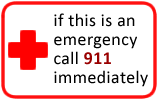Wheezing (Other Than Asthma)
Wheezing (Other Than Asthma)
Does this describe your child's symptoms? |
Definition
Causes
Return to Day Care
|
If not, see these topics
|
When to Call Your Doctor |
Call 911 Now (your child may need an ambulance) If |
|
|
|
Call Your Doctor Now (night or day) If |
|
|
HOME CARE ADVICE FOR MILD WHEEZING (until you talk with your doctor) |
Warm Fluids for Coughing Spasms: For any bouts of severe coughing, offer warm apple juice or lemonade if over 4 months old. (Reason: These can relax the airway and loosen up sticky secretions). Do not give any cough medicine.
Nasal Washes To Open a Blocked Nose:
Use saline nose drops or spray to loosen up the dried mucus. If not available, can use warm tap water.
STEP 1: Instill 3 drops per nostril. (Age under 1 year, use 1 drop and do one side at a time)
STEP 2: Blow (or suction) each nostril separately, while closing off the other nostril. Then do other side.
STEP 3: Repeat nose drops and blowing (or suctioning) until the discharge is clear.
Frequency: Do nasal washes whenever your child can't breathe through the nose.
Saline nasal sprays can be purchased without a prescription.
Saline nose drops can also be made: Add 1/2 teaspoon (2 ml) of table salt to 1 cup (8 ounces or 240 ml) of warm water.
Reason for nose drops: suction or nose blowing alone can't remove dried or sticky mucus.
Another option: use a warm shower to loosen mucus. Breathe in the moist air, then blow each nostril.
For young children, can also use a wet cotton swab to remove sticky mucus.
Importance for a young infant: can't nurse or drink from a bottle unless the nose is open.
Humidifier: If the air is dry in your home, run a humidifier.
Smaller Feedings: Encourage small, frequent feedings whenever your child has the energy to drink. (Reason: Child with wheezing doesn't have enough energy for long feedings).
Avoid Tobacco Smoke: Active or passive smoking makes coughs much worse.
Contagiousness: Your child can return to child care after the wheezing and fever are gone.
Call Your Doctor If:
Breathing becomes difficult, tight or loud
Wheezing becomes worse
And remember, contact your doctor if your child develops any of the "Call Your Doctor" symptoms.
Updated:
March 22, 2017



